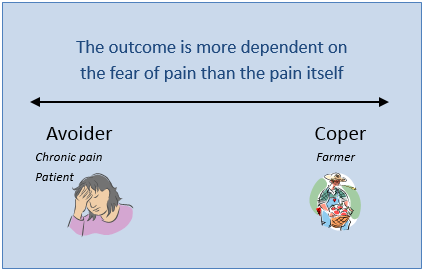Fear of pain and fear of doing damage to an injured body part can be a major impediment to recovery. The fear avoidance model was developed about 20 years ago in an attempt to explain why a minority of people with back pain develop long term problems while most recover. The model suggests that people react to pain depending on how they interpret it. Individuals can perceive pain in one of two ways:
| A. | Non threatening and understandable |
When people experience pain this way, they are likely to keep up their normal activities. This promotes recovery. They 'cope' with pain and get on with their lives. For example, a farmer may respond to a sore back by changing the way he moves the bales of hay and take some anti inflammatory medication if the pain is bad.
| B. | Damaging or harmful |
Perceiving pain in this way can make people more fearful of painful activities. This means an increase in avoidance behaviour, a heightened awareness of pain, and an increased focus on avoiding pain. This can slow or prevent recovery. The patient is fearful of back pain regularly self monitors their level of pain. Increased soreness while undertaking an activity results in increased worry, and that activity may be avoided in the future.
At one end of the spectrum is the stoical individual, the pain confronter (the farmer). This individual experiences pain, confronts it, then moves on with life and essentially self-rehabilitates without recourse to medical attention. At the other end of the spectrum is the individual who avoids the pain experience and pain activity. They are fearful of pain and endeavour to avoid any fresh exposure to pain. Physically this can lead to loss of flexibility, loss of muscular strength and weight gain. Psychological consequences include isolation, depression, and loss of opportunity or work.

People who are fearful of their condition are more likely to keep searching for a biomedical explanation, have multiple investigations and treatment from which they did not gain much benefit.
Medical practitioners can increase a patient's fear using terms such as degenerate or ruptured disc. If treating practitioners are fear avoidant themselves, i.e. they believe activity may do harm, then they are likely to be focused on medical causes.
|
![]() What's next?
What's next?
Other situations where prolonged absence is more likely